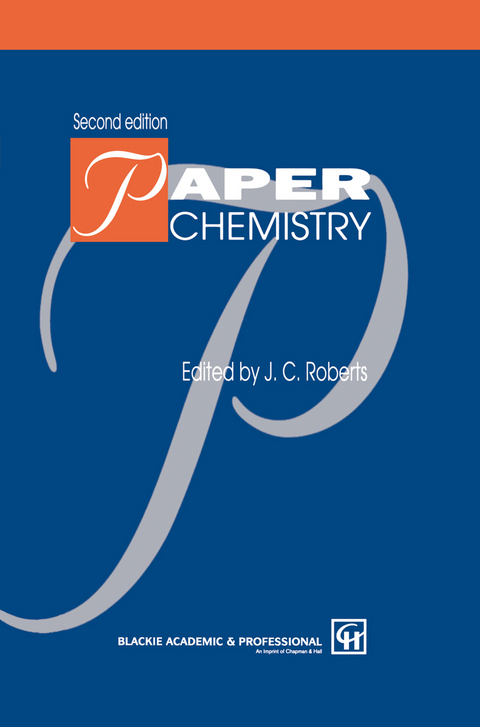
Paper Chemistry
Chapman and Hall (Verlag)
978-0-7514-0236-0 (ISBN)
1 Applications of paper chemistry.- 1.1 Introduction.- 1.2 Paper chemical use in specific product grades.- 1.3 Trends in paper chemical use.- References.- 2 Accessibility of cellulose.- 2.1 Introduction.- 2.2 The concept of accessibility.- 2.3 Determination of crystallinity/accessibility of cellulose.- References.- 3 Electrokinetics of the papermaking industry.- 3.1 Introduction.- 3.2 The electrical double layer.- 3.3 Origin of the charge on papermaking fines, fibres, mineral pigments and fillers.- 3.4 The classical coagulation theory, DLVO theory.- 3.5 Electrophoresis and electrokinetic phenomena – calculation of the zeta potential.- 3.6 Some experimental methods of determining the zeta potential.- 3.7 Polyelectrolyte titrations.- References.- 4 Mechanisms of flocculation and stabilisation of suspensions by organic polymers.- 4.1 Introduction.- 4.2 Behaviour of suspensions of bare particles.- 4.3 A brief insight into polymer conformations in solution and at solid/liquid interfaces.- 4.4 Effect of nonionic polymers on suspension stability: Bridging flocculation and steric stabilization.- 4.5 Flocculation by polyelectrolytes.- 4.6 Conclusions.- References.- 5 Retention aids.- 5.1 Introduction.- 5.2 The chemical nature of retention aids.- 5.3 Mode of action of retention aids.- 5.4 Concluding remarks.- References.- 6 Dry-strength additives.- 6.1 Introduction.- 6.2 Cationic starch.- 6.3 Vegetable gums.- 6.4 Polyacrylamide resins.- References.- 7 Wet-strength chemistry.- 7.1 Introduction.- 7.2 Mechanisms of wet-strength development.- 7.3 The chemistry and application of commercial wet-strength resins.- 7.4 Testing of wet-strength papers.- 7.5 Assessing the efficiency of wet-strength resins.- 7.6 Future trends.- References.- 8 The sizing of paper with rosin and alum at acidpHs.- 8.1 Introduction.- 8.2 Background.- 8.3 Sizing theories.- 8.4 Rosin sizing at pHs greater than 5.5.- 8.5 Summary.- References.- 9 Neutral and alkaline sizing.- 9.1 Introduction.- 9.2 Reasons for changing to neutral sizing.- 9.3 Alkyl ketene dinners.- 9.4 Alkenyl succinic anhydride.- 9.5 Comparisons between AKD and ASA sizing.- 9.6 Neutral rosin sizing systems.- References.- 10 Dyes and fluorescent whitening agents for paper.- 10.1 Introduction.- 10.2 Basic concepts of colour.- 10.3 Classification of dyes and pigments.- 10.4 Dyes and pigments for paper.- 10.5 Application of dyes and pigments for paper.- 10.6 Fluorescent whitening agents (FWAs).- 10.7 Ecotoxicology.- Acknowledgements.- References.- 11 Physical and chemical aspects of the use of fillers in paper.- 11.1 Introduction.- 11.2 Filler properties.- 11.3 Retention.- 11.4 The effect of filler on paper properties.- 11.5 General summary.- References.- 12 Measurement and control.- 12.1 Introduction.- 12.2 Current status of wet-end chemistry measurement.- 12.3 Problems in measurement and control in wet-end chemistry.- 12.4 On-line wet-end chemistry instrumentation.- 12.5 Process control in wet-end chemistry.- 12.6 On-line retention monitoring systems.- 12.7 Monitoring of on-line surface charge.- 12.8 Methodology for complete automatic retention control.- 12.9 Applicability of new sensing devices and techniques.- 12.10 Concluding remarks.- References.- 13 Practical applications of paper chemistry.- 13.1 Introduction.- 13.2 Retention.- 13.3 Starch.- 13.4 Sizing.- 13.5 Deposit control.- 13.6 Difficulties and limitations of practical applications.- References.
| Zusatzinfo | XIII, 267 p. |
|---|---|
| Verlagsort | London |
| Sprache | englisch |
| Maße | 155 x 235 mm |
| Themenwelt | Naturwissenschaften ► Chemie ► Organische Chemie |
| Technik ► Maschinenbau | |
| ISBN-10 | 0-7514-0236-2 / 0751402362 |
| ISBN-13 | 978-0-7514-0236-0 / 9780751402360 |
| Zustand | Neuware |
| Haben Sie eine Frage zum Produkt? |
aus dem Bereich


